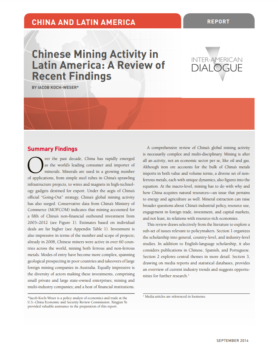The Politics Of Disaster Relief
After a 7.0 magnitude earthquake struck Haiti, the aftershock reached China in ways that few anticipated.The earthquake forced Chinese leaders to navigate the tricky politics of disaster relief.
On April 9, the Inter-American Dialogue hosted What Role for China in LAC’s Covid-19 Recovery?, a conference call with Joyce Chang, Dialogue member and managing director and chair of Global Research at JP Morgan, and Oliver Stuenkel, associate professor of international relations at the Getulio Vargas Foundation (FGV) in São Paulo. The discussion was moderated by Margaret Myers, director of the Asia and Latin America program at the Dialogue.
The Latin American region’s recovery prospects are uniquely tied to China’s, as Chang noted in her initial commentary. According to JP Morgan estimates, every one percentage point decline in Chinese growth takes about one half of a percent off of global growth. But for Latin America that correlation is 1:1—a one percentage point decline in China’s own growth results in a one percentage point decline for the Latin American region.
The good news, as Chang noted, is that China is showing some evidence of economic recovery after eleven weeks of closures. Moreover, most analysts are projecting a V-shaped recovery for China’s economy in the coming months.
That said, China is far from back to normal at this point. And Chinese industry will continue to face economic headwinds as the rest of the world grapples with the effects of Covid-19. Weaker exports will very likely lead to higher unemployment and more corporate bankruptcies, Chang suggested.
Although signs of economic growth in China are generally positive for Latin American economies, Chinese engagement with the region is unlikely to lessen the economic fallout from Covid-19 to the same degree that it did after the 2008 global financial crisis. For one thing, China is in a much different economic situation this time around. China’s post-2008 stimulus amounted to about seven percent of GDP, but this time around it is about half that large. Even with the current stimulus, China will only achieve about 1.1 percent GDP growth in 2020, according to JPMorgan estimates. Overseas engagement will be limited by a lower growth rate, higher fiscal burden, and much higher debt burden, Chang noted.
Stuenkel agreed that while many in the region will look to China to play a role in recovery, China will emerge from this crisis far less capable of helping than it was in the past. To make matters worse, as both speakers noted, the economic situation in Latin America was already exceedingly delicate before the pandemic. With the worst economic performance in the world, the region has had very limited fiscal space to help mitigate the effects of the crisis. And the likelihood of growing political instability in the region will have a further dampening effect on inward investment.
There is nevertheless the possibility of enhanced Chinese engagement with Latin America in those industries in which China is already especially competitive or which will benefit to a degree from Chinese stimulus measures. These include artificial intelligence technologies, automation, and 5G telecommunications, among others. Chang suggested that China will also continue to focus on the provision of medical supplies, knowledge and technologies in the coming months and that we may see some lasting changes in global pharmaceutical supply as a result.
Chang and Stuenkel agreed that future investment will also be shaped by the political economy in Latin America. For example, Stuenkel predicted that arguments against free trade will strengthen in Brazil post-Covid-19. Calls for greater self-sufficiency could result in a considerable resurgence of economic nationalism in Brazil and elsewhere. This is bad news for free trade in the region, he suggested.
Covid-19 has also had an important and probably lasting effect on the so-called US-China-Latin America triangular relationship. As China’s economy continues to recover it will be in an ever better position to lead the world in combating the pandemic, including by sharing information on effective therapeutic treatments or by producing vaccines. In Latin American public opinion, as Stuenkel indicated, the US has played virtually no role in leading the response to the pandemic. There is a perception that a power shift has taken place. Despite pronounced anti-China sentiment in Brazil and some other parts of the region, China is increasingly seen as a key provider of public goods.
Latinoamérica plantea una "gran oportunidad" para inversionistas tras coronavirus (April 13, 2020 – Bnamericas)
How will China help Latin America to recover after the coronavirus crisis? (April 16, 2020 - Latin American Business Stories)
After a 7.0 magnitude earthquake struck Haiti, the aftershock reached China in ways that few anticipated.The earthquake forced Chinese leaders to navigate the tricky politics of disaster relief.
Despite reports in recent months that Mexican manufacturing is experiencing a resurgence, Mexico’s industrial sector faces tremendous challenges.
China has rapidly emerged as the world’s leading consumer and importer of minerals.
 Main Photo: China Development Bank | Wikimedia Commons
Main Photo: China Development Bank | Wikimedia Commons
